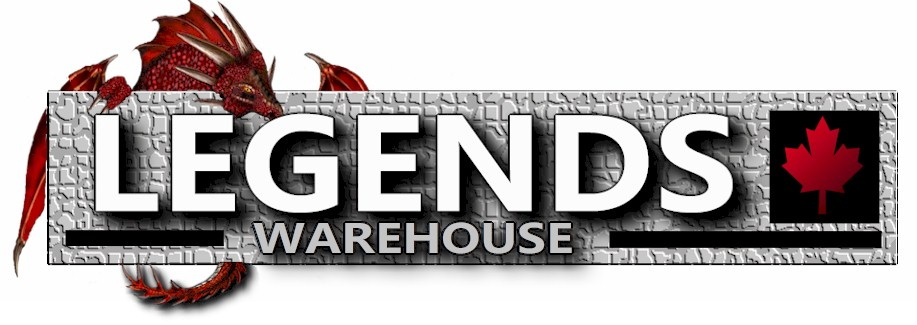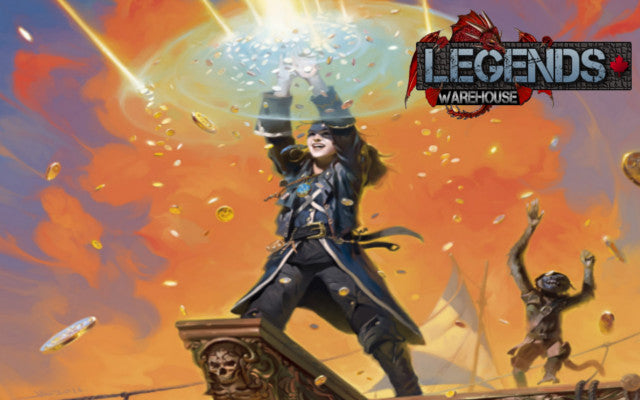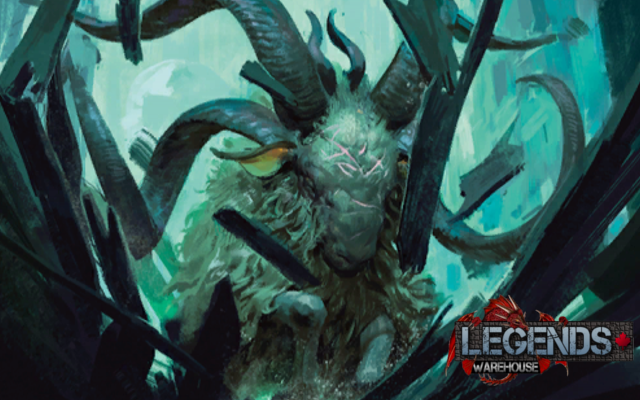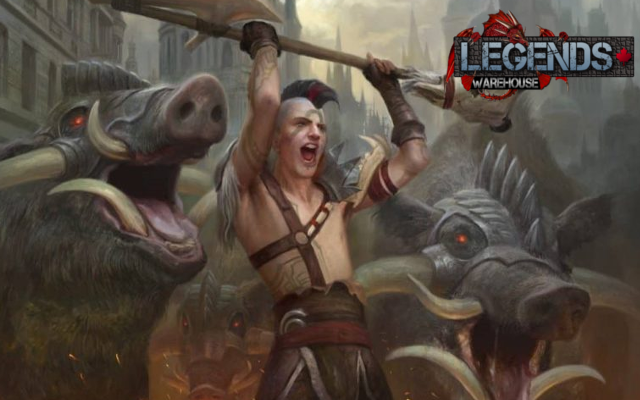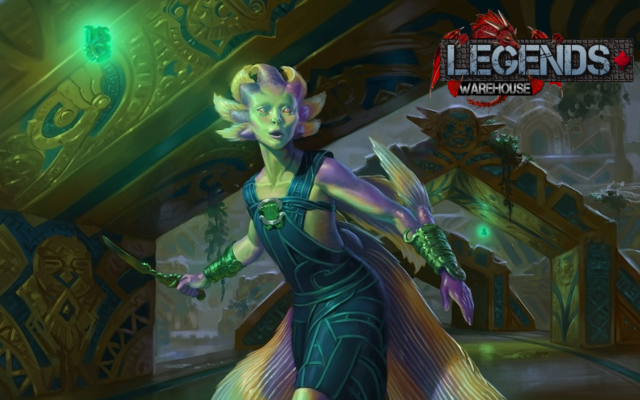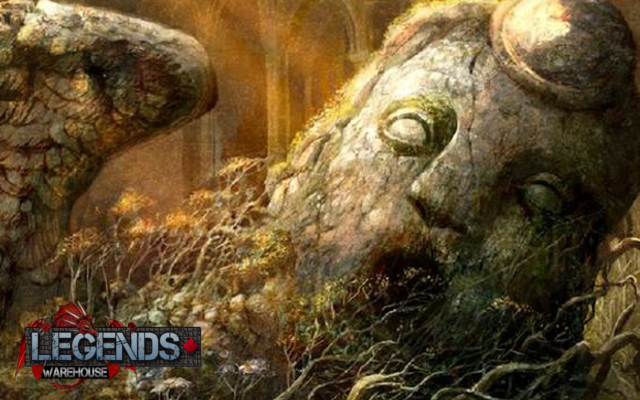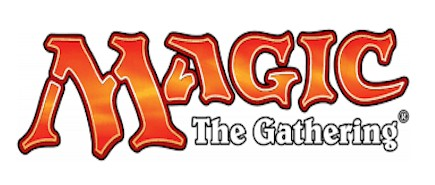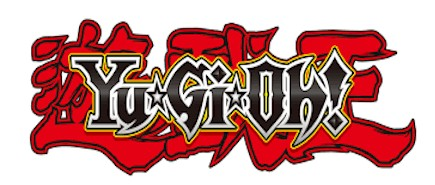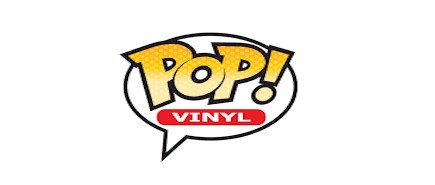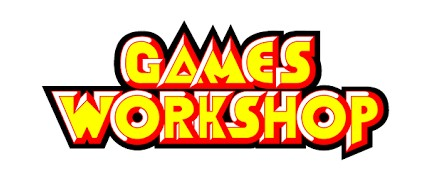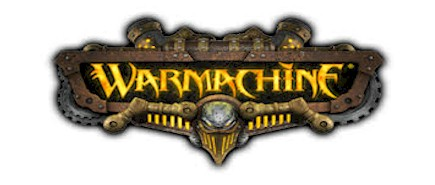Having Standard on a String
- Legends Warehouse News
- 17 Oct, 2017
As you may recall, I’ve been on something of a Marionette Master kick in Standard. In my previous piece on the card, I wrote about the base version of testing that, while powerful in its own right, was still an experiment. After a considerable amount of testing for Canadian Nationals, I’ve come to some conclusions about the deck. There’s no denying that sacrificing a bunch of tokens and hitting the opponent for 20 in a single turn is impressive, and the flexibility of attacking on different angles, such as Tezzeret the Schemer’s emblem or a swarm of Hidden Stockpile tokens, gives the deck a lot of leverage. This is still a powerhouse in an open field, but adjustments have to be made.
- 4 Marionette Master
- 1 The Scarab God
- 4 Tezzeret the Schemer
- 4 Hidden Stockpile
- 4 Treasure Map
- 4 Renegade Map
- 1 Traveler’s Amulet
- 4 Fatal Push
- 3 Fumigate

- 3 Cast Out
- 2 Implement of Examination
- 2 Doomfall
- 2 Spell Swindle
- 2 Fetid Pools
- 2 Glacial Fortress
- 2 Drowned Catacomb
- 4 Concealed Courtyard
- 1 Field of Ruin
- 4 Evolving Wilds
- 3 Swamp
- 2 Plains
- 2 Island
- 1 The Scarab God
- 1 Spell Swindle
- 3 Duress
- 1 Vraska’s Contempt
- 1 Settle the Wreckage
- 1 Field of Ruin
- 2 Negate
- 1 Jace’s Defeat
- 2 Authority of the Consuls
- 1 Anointed Procession
- 1 Lost Legacy
One of the first things I learned about playing this deck was that there were far too many cards that were only good in specific matchups. There were several cards that seemed strong in general, but ended up being more of a specialized answer to single threats. The biggest culprit in my testing was unfortunately Contraband Kingpin. On the surface, it does a lot for the deck, namely repeatable scrying and providing a sizable body against aggro decks. However, after testing it against both aggro and control decks, I found that it under performed. Against control decks, the free scrying was fine, but it had the drawback of turning on all of their Fatal Pushes, and even giving them bodies that they could reanimate with The Scarab God. Against UB Control and UW Approach, leaning on Treasure Map 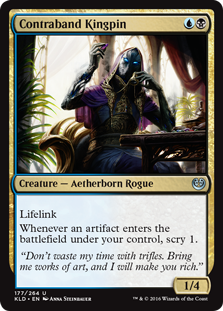 and Hidden Stockpile was much harder for them to interact with, so it already started to lose value in my mind. When I tried it against aggro decks, I found that it only really shined against Ramunap Red. A 1/4 is the perfect size to wall off their threats, but against the various energy decks in the format, or even the Abzan Tokens deck, it was far too small to matter. When Longtusk Cub, another two-drop creature, is attacking for five damage as early as turn 4, Contraband Kingpin is basically just a speed bump, and the Tokens deck went far too wide around it for the lifelink to even matter. As Ramunap Red is steadily replaced by Energy as the king of aggro, the downsides of Contraband Kingpin far outweigh its benefits.
and Hidden Stockpile was much harder for them to interact with, so it already started to lose value in my mind. When I tried it against aggro decks, I found that it only really shined against Ramunap Red. A 1/4 is the perfect size to wall off their threats, but against the various energy decks in the format, or even the Abzan Tokens deck, it was far too small to matter. When Longtusk Cub, another two-drop creature, is attacking for five damage as early as turn 4, Contraband Kingpin is basically just a speed bump, and the Tokens deck went far too wide around it for the lifelink to even matter. As Ramunap Red is steadily replaced by Energy as the king of aggro, the downsides of Contraband Kingpin far outweigh its benefits.
What I’ve considered is taking these slots and turning them into more removal. I was finding that having only two copies of Fatal Push and Fumigate made creature matchups a nightmare if I didn’t draw them on time. Energy decks thrive on an opponent doing nothing and letting them amass energy, so having more answers to their early threats can help buy us time to get us online far better than putting up a blocker that will just get eaten a turn later. Here I found I was hinging more on Hidden Stockpile to chump block their Bristling Hydras and Rogue Refiners, which in turn forced them to over-commit to the board to go around the tokens. This is the perfect setup for sweeping the board with Fumigate, so I’m electing to go up to a third copy in the maindeck. Fumigate is also a game changer against Ramunap Red since you gain life for each destroyed creature, so you get to undo turns of attacking. Overall I feel that while adding more removal adds more dead cards against control decks, there are far more creature decks to worry about in the metagame, so this is the right call.
Control decks were typically pretty easy to beat since they have few ways of interacting with Hidden Stockpile, so the token beatdown plan was at the forefront. The whole goal is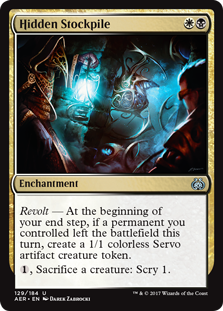 to force them to waste actual cards for tokens, and since Hidden Stockpile can come down early enough that it can’t be countered, we generate a lot of incidental value over the course of a game. The ideal situation is that we have enough tokens to force them to tap out on their own turn for a defender like The Scarab God, enabling us to stick a Marionette Master for the win. The plan of sticking a Tezzeret emblem is also clutch in these matchups since making a 5/5 every turn can quickly close out a game. As such, I wasn’t too worried about tuning the deck against control, but I made a slight concession in adding a copy of The Scarab God to the maindeck and an additional copy in the sideboard to act as both a hard to remove threat and a way to bring back countered Marionette Masters. Since an eternalized Marionette Master enters as a 4/4 already, we can either make servo tokens if we don’t have any tokens available to sacrifice, or fabricate three counters onto the Master to make it a 7/7, thus reducing the number of artifacts needed for a combo kill from five to three. The Scarab God is also strong against Energy decks, so I don’t feel too bad about including it now since we need as much versatility as we can get out of our threats.
to force them to waste actual cards for tokens, and since Hidden Stockpile can come down early enough that it can’t be countered, we generate a lot of incidental value over the course of a game. The ideal situation is that we have enough tokens to force them to tap out on their own turn for a defender like The Scarab God, enabling us to stick a Marionette Master for the win. The plan of sticking a Tezzeret emblem is also clutch in these matchups since making a 5/5 every turn can quickly close out a game. As such, I wasn’t too worried about tuning the deck against control, but I made a slight concession in adding a copy of The Scarab God to the maindeck and an additional copy in the sideboard to act as both a hard to remove threat and a way to bring back countered Marionette Masters. Since an eternalized Marionette Master enters as a 4/4 already, we can either make servo tokens if we don’t have any tokens available to sacrifice, or fabricate three counters onto the Master to make it a 7/7, thus reducing the number of artifacts needed for a combo kill from five to three. The Scarab God is also strong against Energy decks, so I don’t feel too bad about including it now since we need as much versatility as we can get out of our threats.
The last change I made to the maindeck was some tech I picked up from Conley Woods, the originator of the archetype. Pirate’s Prize was a decent enough card, but it was slow 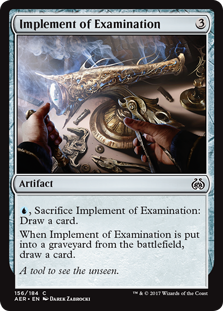 and only made one token for the extra mana. While it was effectively a mana neutral Divination, it didn’t sit well spending four mana just to draw two cards. Implement of Examination is a card that, while it doesn’t do anything if you play it on turn 3, sets up a lot of value the following turn. By being an artifact that can trigger Marionette Master and a sacrifice trigger for Hidden Stockpile, Implement is able to perform its job in the early and late game. What’s also fun about the way Implement draws cards is that you can respond to the separate parts of drawing your two cards. There’s a lot of scrying in the deck, so you can sacrifice the Implement, draw your first card off the trigger, then scry with Hidden Stockpile or Treasure Map with the activated ability on the stack. It’s a cute trick that in slower, grinding matches can give you a lot more control over your draws, as opposed to Pirate’s Prize that just grabs two cards off the top.
and only made one token for the extra mana. While it was effectively a mana neutral Divination, it didn’t sit well spending four mana just to draw two cards. Implement of Examination is a card that, while it doesn’t do anything if you play it on turn 3, sets up a lot of value the following turn. By being an artifact that can trigger Marionette Master and a sacrifice trigger for Hidden Stockpile, Implement is able to perform its job in the early and late game. What’s also fun about the way Implement draws cards is that you can respond to the separate parts of drawing your two cards. There’s a lot of scrying in the deck, so you can sacrifice the Implement, draw your first card off the trigger, then scry with Hidden Stockpile or Treasure Map with the activated ability on the stack. It’s a cute trick that in slower, grinding matches can give you a lot more control over your draws, as opposed to Pirate’s Prize that just grabs two cards off the top.
The sideboard took a bit of an adjustment after seeing how the metagame has evolved in the last week. By moving the Fatal Pushes and a Fumigate to the maindeck, we free up some slots to help diversify our answers. As well, Bontu’s Last Reckoning had enough of a drawback against decks like Energy where it was supposed to be good that I cut it entirely. Doomfall was a fine card in the control matchups, but I found that it was underperforming elsewhere, so I decided that since I already had two in the maindeck, a third copy wasn’t necessary. I’ve also elected to cut Anointer Priest simply because I found that it, like Contraband Kingpin, only did work in the Ramunap Red matchup, and was largely 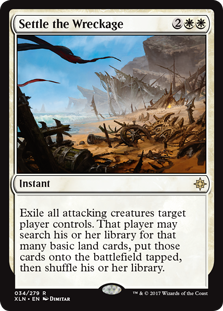 ineffective everywhere else. This gave me five total slots that I could work with.
ineffective everywhere else. This gave me five total slots that I could work with.
To help fill these voids, I looked at cards that had an impact in multiple matchups, rather than answers to single threats. For example, I replaced the slots left by Fatal Push with Authority of the Consuls as a way of fighting hasty threats like Glorybringer and Hazoret the Fervent, but it also does a great job of mitigating the chip damage from Abzan Tokens since the majority of the creatures they put out are 1/1s. The Bontu’s Last Reckoning has been replaced by a Settle the Wreckage, though this could easily just be a fourth copy of Fumigate. I lean more toward Settle because it gets around Heroic Intervention, indestructibility, and The Scarab God’s “when this dies” trigger. While it does ramp them quite a bit, being an instant also gives us the ability to hold up mana for Settle, and if they don’t swing out into it, use that mana on our scry effects instead.
The second copy of The Scarab God is largely there so we can reliably draw it in the matches where it’s a necessary secondary win condition. This is mostly against opposing Black decks that bring in Lost Legacy for our Marionette Masters, but it also has a lot of value against midrange decks like Energy. There’s no denying that The Scarab God is the best creature in Standard right now, so it only stands to reason that an additional copy is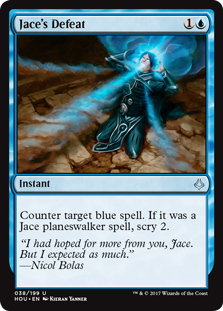 warranted. Speaking of the Scarab God, due to the proliferation of UB Control decks, we need a way to answer Blue creatures before they get a chance to do something powerful. While Essence Scatter would usually be sufficient, I’ve found that we have enough creature kill that something like Jace’s Defeat is much more versatile an answer simply due to the number of potential threats it can stop. Hitting creatures like Torrential Gearhulk or The Scarab God, planeswalkers like Tezzeret the Schemer or Jace, Cunning Castaway, and even opposing counterspells gives the deck a hard answer in the control matchups. Finally, the last addition is a second copy of Field of Ruin. This card is clutch for answering all of the new flip cards since they all turn into lands. As well, certain decks like UB Control and Abzan Tokens hinge their late games on these lands, so having a way to interact with them is necessary for actually stopping them from overwhelming you with card advantage. One fun trick with Field of Ruin is that the shuffle is required, so if the opponent has scryed or, even juicier, dug deep so an Approach of the Second Sun is on top of their deck, they have to shuffle the card away.
warranted. Speaking of the Scarab God, due to the proliferation of UB Control decks, we need a way to answer Blue creatures before they get a chance to do something powerful. While Essence Scatter would usually be sufficient, I’ve found that we have enough creature kill that something like Jace’s Defeat is much more versatile an answer simply due to the number of potential threats it can stop. Hitting creatures like Torrential Gearhulk or The Scarab God, planeswalkers like Tezzeret the Schemer or Jace, Cunning Castaway, and even opposing counterspells gives the deck a hard answer in the control matchups. Finally, the last addition is a second copy of Field of Ruin. This card is clutch for answering all of the new flip cards since they all turn into lands. As well, certain decks like UB Control and Abzan Tokens hinge their late games on these lands, so having a way to interact with them is necessary for actually stopping them from overwhelming you with card advantage. One fun trick with Field of Ruin is that the shuffle is required, so if the opponent has scryed or, even juicier, dug deep so an Approach of the Second Sun is on top of their deck, they have to shuffle the card away.
I’ve been exceedingly happy with the way that the deck has been playing so far, and I know that with these small tweaks it can turn into something even more powerful. Players still aren’t ready to get drained for 20 life in one turn, and with these extra ways to win the game, we have plenty of adaptability going into larger events. As the meta shifts from week to week, it’s important to have options, so these little changes should be more than enough to keep us one step ahead of the game.

